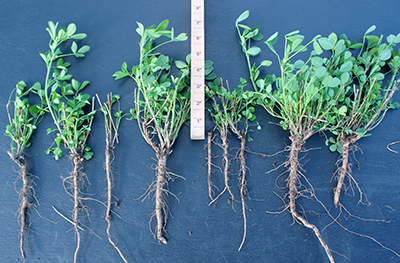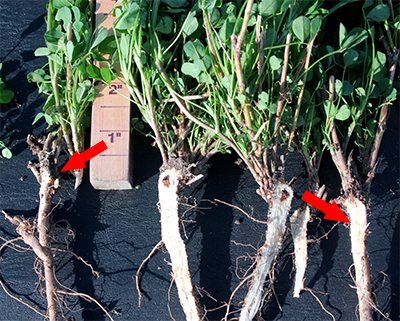Will my alfalfa survive the coming winter?
Stress on the plants influences the long-term survival of alfalfa stands.

During the 2014 growing season, much of Michigan had cooler and wetter weather, preventing many alfalfa producers from being able to harvest high quality dry alfalfa hay on a timely basis. Michigan alfalfa fields responded to the increased water availability to give good yields, but there was also a reduction in quality. Timing of cuttings was inconsistent and many producers took advantage of any sunny and dry conditions to insure the crop was harvested.
Couple the wet summer with all the challenges associated with last winter and many producers are asking themselves what should we expect for the coming year? How will my alfalfa stands survive if we have another tough winter? To answer this, it is important for producers to assess the health of the stand to help anticipate which fields are likely to suffer yield loss due to winterkill.
Recently, I had a chance to assess plant health in two alfalfa stands I have been following since early spring when they showed significant delays when breaking dormancy. Samples from each field were dug and sent to Michigan State University Diagnostic Services to be evaluated for disease. Fusarium and Rhizoctonia were isolated from the crowns of the alfalfa samples. These pathogens are part of the alfalfa crown rot complex that is found in nearly every alfalfa field and is a major factor limiting the persistence of alfalfa stands. The older the stand, the more crown rot typically occurs. These pathogens may infect plants months or years before crown rot develops, and isolation of these pathogens from plants will not necessarily mean that roots will develop crown rot.

One of the monitored alfalfa fields in Sanilac County showing differences in growth in spring (right) and this fall (left).
Research shows that environmental stresses can predispose alfalfa to root and crown rot. Environmental stress can include poor fertility, low soil pH, harvesting too often or too late in the season, grazing or wheel traffic that damages the crowns, excessive drought, flooding, insect attack or winter injury. Anything that depletes root carbohydrate reserves can be a predisposing factor. So, with an increase of stresses on alfalfa plants, the opportunity for secondary infections by crown rot diseases increases. There are no varieties currently available that have resistance to crown rot; however, choosing varieties that have a high degree of resistance to multiple diseases is recommended.

Alfalfa plants showing the variation of fall plant growth due to crown rot or possibly normal thinning of weaker plants.
Each of the two fields I am monitoring yielded well and provided at least average tonnage. When plants were dug this fall, most roots were firm, off-white and had few signs of discoloration. Expectations are for excellent winter survival. Using the rating system 0 to 5, where 0 is best and 5 is worst, I would have given most roots a rating of 1 based on the University of Wisconsin Bulletin A3620, “Alfalfa stand assessment: Is this stand good enough to keep?” It is likely many plants that showed significant signs of crown rot this past spring subsequently died during the summer growing season. In low areas of the fields where drainage is less than ideal, many plants still show injury to root crowns and are rated a 2-3 for injury. These plants will probably not survive the winter.

Split stems showing incidence of crown and stem rot.
For more information, contact Phil Kaatz with Michigan State University Extension at 810-667-0341 or kaatz@msu.edu.
References
- Alfalfa Root and Crown Rot Complex, Kansas State University Extension
- Root and Crown Rots and Virus Diseases of Alfalfa and Clover, University of Illinois at Urbana-Champaign
- Rhizoctonia Root, Stem, and Crown Rot of Alfalfa, Ohio State University Extension
- Alfalfa stand assessment: Is this stand good enough to keep?, University of Wisconsin Extension



 Print
Print Email
Email


